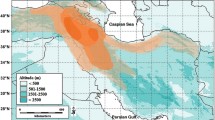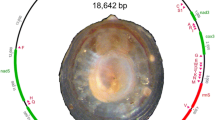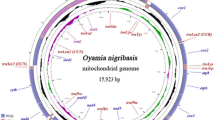Abstract
Hyracoids have been allied with either perissodactyls or tethytheres (i.e., Proboscidea + Sirenia) based on morphological data. The latter hypothesis, termed Paenungulata, is corroborated by numerous molecular studies. However, molecular studies have failed to support Tethytheria, a group that is supported by morphological data. We examined relationships among living paenungulate orders using a multigene data set that included sequences from four mitochondrial genes (12S rRNA, tRNA valine, 16S rRNA, cytochrome b) and four nuclear genes (aquaporin, A2AB, IRBP, vWF). Nineteen maximum-likelihood models were employed, including models with process partitions for base composition and substitution parameterizations. With the inclusion of partitions with a heterogeneous base composition, 18 of 19 models favored Hyracoidea + Sirenia. All 19 models favored Hyracoidea + Sirenia after excluding heterogeneous base composition partitions. Most of the support for Hyracoidea + Sirenia derived from the mitochondrial genes (bootstrap support ranged from 51 to 99%); Tethytheria, in turn, received 0 to 19% support in different analyses. Bootstrap support deriving from the nuclear genes was more evenly split among the competing hypotheses (3 to 45% for Tethytheria; 17.5 to 62% for Hyracoidea + Sirenia). Lineage-specific rate variation among both mitochondrial and nuclear genes may contribute to the different results that were obtained with mitochondrial versus nuclear data. Whether Tethytheria or a competing hypothesis is correct, short internodes on the molecular phylogenies suggest that paenungulate orders diverged from each other over a 5- to 8-million-year time window extending from the late Paleocene into the early Eocene. We also used likelihood-ratio tests to compare different models of sequence evolution. A gamma distribution of rates results in a greater improvement in likelihood scores than does an allowance for invariant sites. Twenty-one rate partitions corresponding to stems, loops, and codon positions of different genes result in higher likelihood scores than a gamma distribution of rates and/or an allowance for invariant sites. Process partitions of the data that incorporate base composition and substitution parameterizations result in significant improvements in likelihood scores in comparison to models that allow only for relative rate differences among partitions.
Similar content being viewed by others
LITERATURE CITED
Coppens, Y., Maglio, V. J., Madden, C. T., and Beden, M. (1978). Proboscidea. In: Evolution of East African Mammals, V. J. Maglio and H. B. S. Cooke, eds., pp. 336–367, Harvard University Press, London.
Court, N. (1994). The periotic of Moeritherium (Mammalia, Proboscidea): Homology or homoplasy in the ear region of Tethytheria McKenna, 1975? Zool. J. Linn. Soc. 112: 13–28.
de Jong, W. W., Zweers, A., and Goodman, M. (1981). Relationship of aardvark to elephants, hyraxes, and sea cows from alpha-crystallin sequences. Nature 292: 538–540.
de Jong, W. W., Leunissen, J. A. M., and Wistow, G. J. (1993). Eye lens crystallins and the phylogeny of placental orders: Evidence for a macroscelid-paenungulate clade? In: Mammal Phylogeny: Placentals, F. S. Szalay, M. J. Novacek, and M. C. McKenna, eds., pp. 5–12, Springer-Verlag, New York.
Domning, D. P., Ray, C. E., and McKenna, M. C. (1986). Two new Oligocene desmostylians and a discussion of tethytherian systematics. Smithson. Contrib. Paleobiol. 59: 1–56.
Felsenstein, J. (1981). Evolutionary trees from DNA sequences: A maximum likelihood approach. J. Mol. Evol. 17: 368–376.
Fischer, M. S. (1989). Hyracoids, the sister-group of perissodactyls. In: The Evolution of Perissodactyls, D. R. Prothero and R. M. Schoch, eds., pp. 37–56, Oxford University Press, New York.
Fischer, M. S., and Tassy, P. (1993). The interrelation between Proboscidea, Sirenia, Hyracoidea, and Mesaxonia: The morphological evidence. In: Mammal Phylogeny: Placentals, F. S. Szalay, M. J. Novacek, and M. C. McKenna, eds., pp. 217–234, Springer-Verlag, New York.
Gheerbrant, E., Sudre, J., and Cappetta, H. (1996). A Palaeocene proboscidean from Morocco. Nature 383: 68–70.
Hasegawa, M., Kishino, H., and Yano, T. (1985). Dating the human-ape split by a molecular clock of mitochondrial DNA. J. Mol. Evol. 22: 160–174.
Huelsenbeck, J. P. (1995). Performance of phylogenetic methods in simulation. Syst. Biol. 44: 17–48.
Huelsenbeck, J. P., and Crandall, K. A. (1997). Phylogeny estimation and hypothesis testing using maximum likelihood. Annu. Rev. Ecol. Syst. 28: 437–466.
Huelsenbeck, J. P., and Rannala, B. (1997). Phylogenetic methods come of age: Testing hypotheses in an evolutionary context. Science 276: 227–232.
Kishino, H., and Hasegawa, M. (1989). Evaluation of the maximum likelihood estimate of the evolutionary tree topologies from DNA sequence data, and the branching order of Hominoidea. J. Mol. Evol. 29: 170–179.
Krajewski, C., Blacket, M., Buckley, L., and Westerman, M. (1997). A multigene assessment of phylogenetic relationships within the dasyurid marsupial subfamily Sminthopsinae. Mol. Phylogenet. Evol. 8: 236–248.
Lanave, C., Preparata, G., Saccone, C., and Serio, G. (1984). A new method for calculating evolutionary substitution rates. J. Mol. Evol. 20: 86–93.
Lavergne, A., Douzery, E., Stichler, T., Catzeflis, F. M., and Springer, M. S. (1996). Interordinal mammalian relationships: Evidence for paenungulate monophyly is provided by complete mitochondrial 12S rRNA sequences. Mol. Phylogenet. Evol. 6: 245–258.
Madsen, O., Deen, P. M. T., Pesole, G., Saccone, C., and de Jong, W. W. (1997). Molecular evolution of mammalian aquaporin-2: Further evidence that elephant shrew and aardvark join the Paenungulata. Mol. Biol. Evol. 14: 363–371.
McKenna, M. C. (1975). Toward a phylogenetic classification of the Mammalia. In: Phylogeny of the Primates: An Interdisciplinary Approach, W. P. Luckett and F. S. Szalay, eds. pp. 21–46, Plenum Press, New York.
McKenna, M. C., and Bell, S. K. (1997). Classification of Mammals Above the Species Level, Columbia University Press, New York.
Novacek, M. J. (1986). The primitive eutherian dental formula. J. Vert. Paleont. 6: 191–196.
Novacek, M. J. (1992). Fossils, topologies, missing data, and the higher phylogeny of eutherian mammals. Syst. Biol. 41: 58–73.
Novacek, M. J., Wyss, A. R., and McKenna, M. C. (1988). The major groups of eutherian mammals. In: The Phylogeny and Classification of the Tetrapods, Vol. 2: Mammals, M. J. Benton, ed., pp. 31–71, The Systematics Association, Clarendon, Oxford.
Porter, C. A., Goodman, M., and Stanhope, M. J. (1996). Evidence on mammalian phylogeny from sequences of exon 28 of the von Willebrand Factor gene. Mol. Phylogenet. Evol. 5: 89–101.
Shoshani, J. (1986). Mammalian phylogeny: Comparison of morphological and molecular results. Mol. Biol. Evol. 3: 222–242.
Shoshani, J. (1993). Hyracoidea-Tethytheria affinity based on myological data. In: Mammal Phylogeny: Placentals, F. S. Szalay, M. J. Novacek, and M. C. McKenna, eds., pp. 235–256, Springer-Verlag, New York.
Shoshani, J., and McKenna, M. C. (1998). Higher taxonomic relationships among extant mammals based on morphology, with selected comparisons of results from molecular data. Mol. Phylogenet. Evol. 9: 572–584.
Springer, M. S. (1997). Molecular clocks and the timing of the placental and marsupial radiations in relation to the Cretaceous-Tertiary boundary. J. Mammal. Evol. 4: 285–302.
Springer, M. S., Burk, A., Kavanagh, J. R., Waddell, V. G., and Stanhope, J. J. (1997a). The interphotoreceptor retinoid binding protein gene in therian mammals: Implications for higher level relationships and evidence for loss of function in the marsupial mole. Proc. Natl. Acad. Sci. USA 94: 13754–13759.
Springer, M. S., Cleven, G. C., Madsen, O., de Jong, W. W., Waddell, V. G., Amrine, H. M., and Stanhope, M. J. (1997b). Endemic African mammals shake the phylogenetic tree. Nature 388: 61–64.
Springer, M. S., Amrine, H. M., Burk, A., and Stanhope, M. J. (1999). Additional support for Afrotheria and Paenungulata, the performance of mitochondrial and nuclear genes, and the impact of data partitions with heterogeneous base composition. Syst. Biol. 48: 65–75.
Stanhope, M. J., Smith, M. R., Waddell, V. G., Porter, C. A., Shivji, M. S., and Goodman, M. (1996). Mammalian evolution and the interphotoreceptor retinoid binding protein (IRBP) gene: Convincing evidence for several superordinal clades. J. Mol. Evol. 43: 83–92.
Stanhope, M. J., Madsen, O., Waddell, V. G., Cleven, G. C., de Jong, W. W., and Springer, M. S. (1998a). Highly congruent molecular support for a diverse superordinal clade of endemic African mammals. Mol. Phylogenet. Evol. 9: 501–508.
Stanhope, M. J., Waddell, V. G., Madsen, O., de Jong, W. W., Hedges, S. B., Cleven, G. C., Kao, D., and Springer, M. S. (1998b). Molecular evidence for multiple origins of Insectivora and for a new order of endemic African insectivore mammals. Proc. Natl. Acad. Sci. USA 95: 9967–9972.
Sullivan, J., and Swofford, D. L. (1997). Are guinea pigs rodents? The importance of adequate models in molecular phylogenetics. J. Mammal. Evol. 4: 77–86.
Swofford, D. L. (1998). PAUP*. Phylogenetic Analysis Using Parsimony (* and Other Methods), Version 4, Sinauer Associates, Sunderland, MA.
Swofford, D. L., Olsen, G. J., Waddell, P. J., and Hillis, D. M. (1996). Phylogenetic inference. In: Molecular Systematics, D. M. Hillis, C. Moritz, and B. K. Mable, eds., pp. 407–514, Sinauer, Sunderland, MA.
Tassy, P., and Shoshani, J. (1988). The Tethytheria: Elephants and their relatives. In: The Phylogeny and Classification of the Tetrapods, Vol. 2: Mammals, M. J. Benton, ed., pp. 283–315, The Systematics Association, Clarendon, Oxford.
Waddell, P. J., and Penny, D. (1996). Evolutionary trees of apes and humans from DNA sequences. In: Handbook of Symbolic Evolution, A. J. Lock and C. R. Peters, eds., pp. 53–73, Clarendon Press, Oxford.
Yang, Z. (1994). Maximum likelihood estimation from DNA sequences with variable rates over sites: Approximate methods. J. Mol. Evol. 39: 306–314.
Author information
Authors and Affiliations
Rights and permissions
About this article
Cite this article
Amrine, H.M., Springer, M.S. Maximum-Likelihood Analysis of the Tethythere Hypothesis Based on a Multigene Data Set and a Comparison of Different Models of Sequence Evolution. Journal of Mammalian Evolution 6, 161–176 (1999). https://doi.org/10.1023/A:1020672105486
Issue Date:
DOI: https://doi.org/10.1023/A:1020672105486




